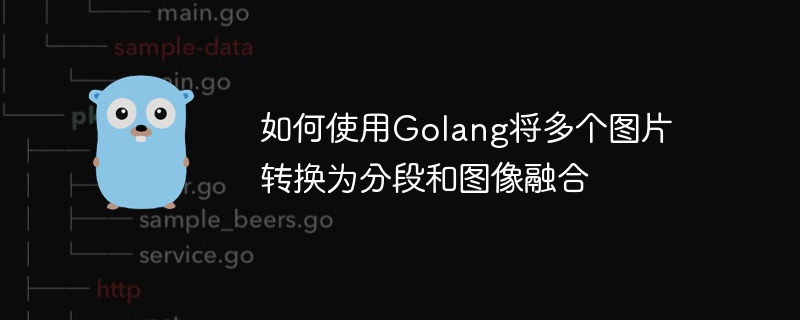如何使用Golang將多張圖片轉換為分段和影像融合

如何使用Golang將多個圖片轉換為分段和圖像融合
概述:
在本文中,我們將使用Golang程式語言展示如何將多個圖片轉換為分段和影像融合。我們將使用Golang的圖像處理庫和簡單的演算法來實現這個過程。透過將多個圖片轉換為圖像的不同部分,然後將它們融合在一起,我們可以創建一個新的有趣和獨特的圖像。
步驟1: 導入所需的函式庫
首先,我們需要導入Golang的影像處理函式庫以及其他所需的函式庫。在我們的程式碼中,我們將使用image和os函式庫。
package main
import (
"fmt"
"image"
_ "image/jpeg"
"image/png"
"os"
)步驟2: 載入多個圖片
接下來,我們需要載入多個圖片。我們可以使用Golang的image.Decode函數來載入圖片檔案。
func loadImage(path string) (image.Image, error) {
file, err := os.Open(path)
if err != nil {
return nil, err
}
defer file.Close()
img, _, err := image.Decode(file)
if err != nil {
return nil, err
}
return img, nil
}
func loadImages(paths []string) ([]image.Image, error) {
var images []image.Image
for _, path := range paths {
img, err := loadImage(path)
if err != nil {
return nil, err
}
images = append(images, img)
}
return images, nil
}步驟3: 分割圖片
接下來,我們將實作一個函數來將圖片分割成多個部分。我們可以使用Golang的image庫來取得圖片的寬度和高度,並根據需要分割成相等大小的部分。
func splitImage(img image.Image, rows, cols int) [][]image.Image {
bounds := img.Bounds()
width := bounds.Max.X - bounds.Min.X
height := bounds.Max.Y - bounds.Min.Y
cellWidth := width / cols
cellHeight := height / rows
var splitImages [][]image.Image
for row := 0; row < rows; row++ {
var rowImages []image.Image
for col := 0; col < cols; col++ {
x := bounds.Min.X + col*cellWidth
y := bounds.Min.Y + row*cellHeight
r := image.Rect(x, y, x+cellWidth, y+cellHeight)
subImage := imaging.Crop(img, r)
rowImages = append(rowImages, subImage)
}
splitImages = append(splitImages, rowImages)
}
return splitImages
}步驟4: 影像融合
最後,我們將實作一個函數來將分割後的圖片融合在一起。在這個例子中,我們將使用簡單的演算法,將每個時刻的像素值累積起來,並對結果取平均值。
func mergeImages(images [][]image.Image) image.Image {
rows := len(images)
cols := len(images[0])
cellWidth := images[0][0].Bounds().Dx()
cellHeight := images[0][0].Bounds().Dy()
merged := image.NewRGBA(image.Rect(0, 0, cellWidth*cols, cellHeight*rows))
for row := 0; row < rows; row++ {
for col := 0; col < cols; col++ {
x := col * cellWidth
y := row * cellHeight
subImage := images[row][col]
rect := image.Rect(x, y, x+cellWidth, y+cellHeight)
draw.Draw(merged, rect, subImage, image.Point{}, draw.Over)
}
}
return merged
}步驟5: 完整程式碼範例
下面是一個完整的程式碼範例,示範如何將多個圖片轉換為分段和圖像融合。
package main
import (
"fmt"
"image"
_ "image/jpeg"
"image/png"
"os"
)
func loadImage(path string) (image.Image, error) {
file, err := os.Open(path)
if err != nil {
return nil, err
}
defer file.Close()
img, _, err := image.Decode(file)
if err != nil {
return nil, err
}
return img, nil
}
func loadImages(paths []string) ([]image.Image, error) {
var images []image.Image
for _, path := range paths {
img, err := loadImage(path)
if err != nil {
return nil, err
}
images = append(images, img)
}
return images, nil
}
func splitImage(img image.Image, rows, cols int) [][]image.Image {
bounds := img.Bounds()
width := bounds.Max.X - bounds.Min.X
height := bounds.Max.Y - bounds.Min.Y
cellWidth := width / cols
cellHeight := height / rows
var splitImages [][]image.Image
for row := 0; row < rows; row++ {
var rowImages []image.Image
for col := 0; col < cols; col++ {
x := bounds.Min.X + col*cellWidth
y := bounds.Min.Y + row*cellHeight
r := image.Rect(x, y, x+cellWidth, y+cellHeight)
subImage := imaging.Crop(img, r)
rowImages = append(rowImages, subImage)
}
splitImages = append(splitImages, rowImages)
}
return splitImages
}
func mergeImages(images [][]image.Image) image.Image {
rows := len(images)
cols := len(images[0])
cellWidth := images[0][0].Bounds().Dx()
cellHeight := images[0][0].Bounds().Dy()
merged := image.NewRGBA(image.Rect(0, 0, cellWidth*cols, cellHeight*rows))
for row := 0; row < rows; row++ {
for col := 0; col < cols; col++ {
x := col * cellWidth
y := row * cellHeight
subImage := images[row][col]
rect := image.Rect(x, y, x+cellWidth, y+cellHeight)
draw.Draw(merged, rect, subImage, image.Point{}, draw.Over)
}
}
return merged
}
func main() {
paths := []string{"image1.jpg", "image2.jpg", "image3.jpg"}
images, err := loadImages(paths)
if err != nil {
fmt.Println("Failed to load images:", err)
return
}
rows := 2
cols := 2
splitImages := splitImage(images[0], rows, cols)
merged := mergeImages(splitImages)
output, err := os.Create("output.png")
if err != nil {
fmt.Println("Failed to create output file:", err)
return
}
defer output.Close()
err = png.Encode(output, merged)
if err != nil {
fmt.Println("Failed to encode output file:", err)
return
}
fmt.Println("Image conversion and merging is done!")
}總結:
以上是使用Golang將多個圖片轉換為分段和影像融合的步驟和程式碼範例。透過使用Golang的圖像處理庫和簡單的演算法,我們可以輕鬆實現這個過程。你可以根據需要調整分割和融合的參數,創造出不同形式和風格的影像。希望這篇文章對你有幫助!
以上是如何使用Golang將多張圖片轉換為分段和影像融合的詳細內容。更多資訊請關注PHP中文網其他相關文章!

熱AI工具

Undresser.AI Undress
人工智慧驅動的應用程序,用於創建逼真的裸體照片

AI Clothes Remover
用於從照片中去除衣服的線上人工智慧工具。

Undress AI Tool
免費脫衣圖片

Clothoff.io
AI脫衣器

Video Face Swap
使用我們完全免費的人工智慧換臉工具,輕鬆在任何影片中換臉!

熱門文章

熱工具

記事本++7.3.1
好用且免費的程式碼編輯器

SublimeText3漢化版
中文版,非常好用

禪工作室 13.0.1
強大的PHP整合開發環境

Dreamweaver CS6
視覺化網頁開發工具

SublimeText3 Mac版
神級程式碼編輯軟體(SublimeText3)
 如何使用 Golang 安全地讀取和寫入檔案?
Jun 06, 2024 pm 05:14 PM
如何使用 Golang 安全地讀取和寫入檔案?
Jun 06, 2024 pm 05:14 PM
在Go中安全地讀取和寫入檔案至關重要。指南包括:檢查檔案權限使用defer關閉檔案驗證檔案路徑使用上下文逾時遵循這些準則可確保資料的安全性和應用程式的健全性。
 如何為 Golang 資料庫連線配置連線池?
Jun 06, 2024 am 11:21 AM
如何為 Golang 資料庫連線配置連線池?
Jun 06, 2024 am 11:21 AM
如何為Go資料庫連線配置連線池?使用database/sql包中的DB類型建立資料庫連線;設定MaxOpenConns以控制最大並發連線數;設定MaxIdleConns以設定最大空閒連線數;設定ConnMaxLifetime以控制連線的最大生命週期。
 如何在 Golang 中將 JSON 資料保存到資料庫中?
Jun 06, 2024 am 11:24 AM
如何在 Golang 中將 JSON 資料保存到資料庫中?
Jun 06, 2024 am 11:24 AM
可以透過使用gjson函式庫或json.Unmarshal函數將JSON資料儲存到MySQL資料庫中。 gjson函式庫提供了方便的方法來解析JSON字段,而json.Unmarshal函數需要一個目標類型指標來解組JSON資料。這兩種方法都需要準備SQL語句和執行插入操作來將資料持久化到資料庫中。
 Golang框架與Go框架:內部架構與外部特性對比
Jun 06, 2024 pm 12:37 PM
Golang框架與Go框架:內部架構與外部特性對比
Jun 06, 2024 pm 12:37 PM
GoLang框架與Go框架的差異體現在內部架構與外部特性。 GoLang框架基於Go標準函式庫,擴充其功能,而Go框架由獨立函式庫組成,以實現特定目的。 GoLang框架更靈活,Go框架更容易上手。 GoLang框架在效能上稍有優勢,Go框架的可擴充性更高。案例:gin-gonic(Go框架)用於建立RESTAPI,而Echo(GoLang框架)用於建立Web應用程式。
 從前端轉型後端開發,學習Java還是Golang更有前景?
Apr 02, 2025 am 09:12 AM
從前端轉型後端開發,學習Java還是Golang更有前景?
Apr 02, 2025 am 09:12 AM
後端學習路徑:從前端轉型到後端的探索之旅作為一名從前端開發轉型的後端初學者,你已經有了nodejs的基礎,...
 golang框架開發實戰教學:常見疑問解答
Jun 06, 2024 am 11:02 AM
golang框架開發實戰教學:常見疑問解答
Jun 06, 2024 am 11:02 AM
Go框架開發常見問題:框架選擇:取決於應用需求和開發者偏好,如Gin(API)、Echo(可擴展)、Beego(ORM)、Iris(效能)。安裝和使用:使用gomod指令安裝,導入框架並使用。資料庫互動:使用ORM庫,如gorm,建立資料庫連線和操作。身份驗證和授權:使用會話管理和身份驗證中間件,如gin-contrib/sessions。實戰案例:使用Gin框架建立一個簡單的部落格API,提供POST、GET等功能。
 Go語言中哪些庫是由大公司開發或知名的開源項目提供的?
Apr 02, 2025 pm 04:12 PM
Go語言中哪些庫是由大公司開發或知名的開源項目提供的?
Apr 02, 2025 pm 04:12 PM
Go語言中哪些庫是大公司開發或知名開源項目?在使用Go語言進行編程時,開發者常常會遇到一些常見的需求,�...
 Golang的目的:建立高效且可擴展的系統
Apr 09, 2025 pm 05:17 PM
Golang的目的:建立高效且可擴展的系統
Apr 09, 2025 pm 05:17 PM
Go語言在構建高效且可擴展的系統中表現出色,其優勢包括:1.高性能:編譯成機器碼,運行速度快;2.並發編程:通過goroutines和channels簡化多任務處理;3.簡潔性:語法簡潔,降低學習和維護成本;4.跨平台:支持跨平台編譯,方便部署。






